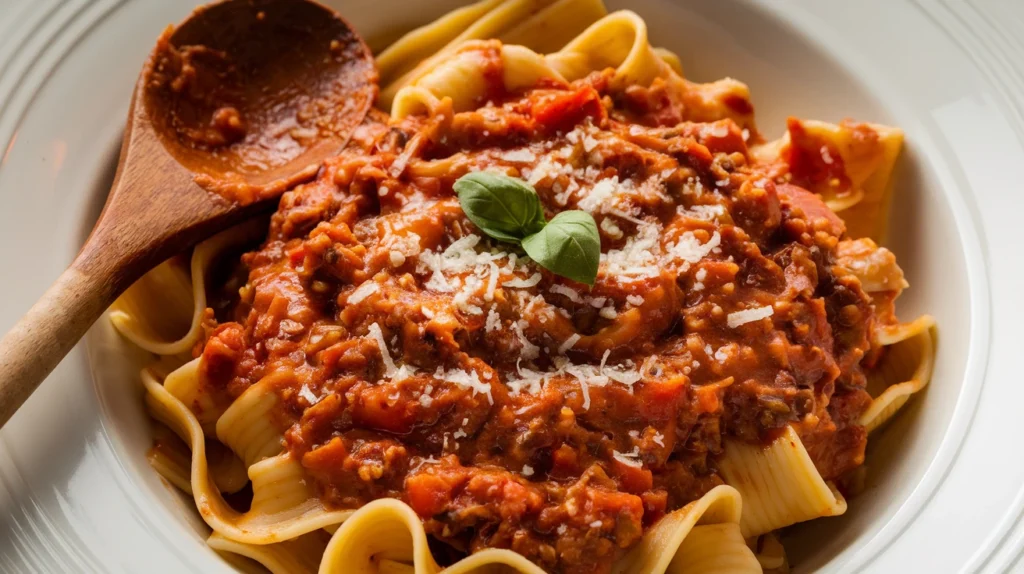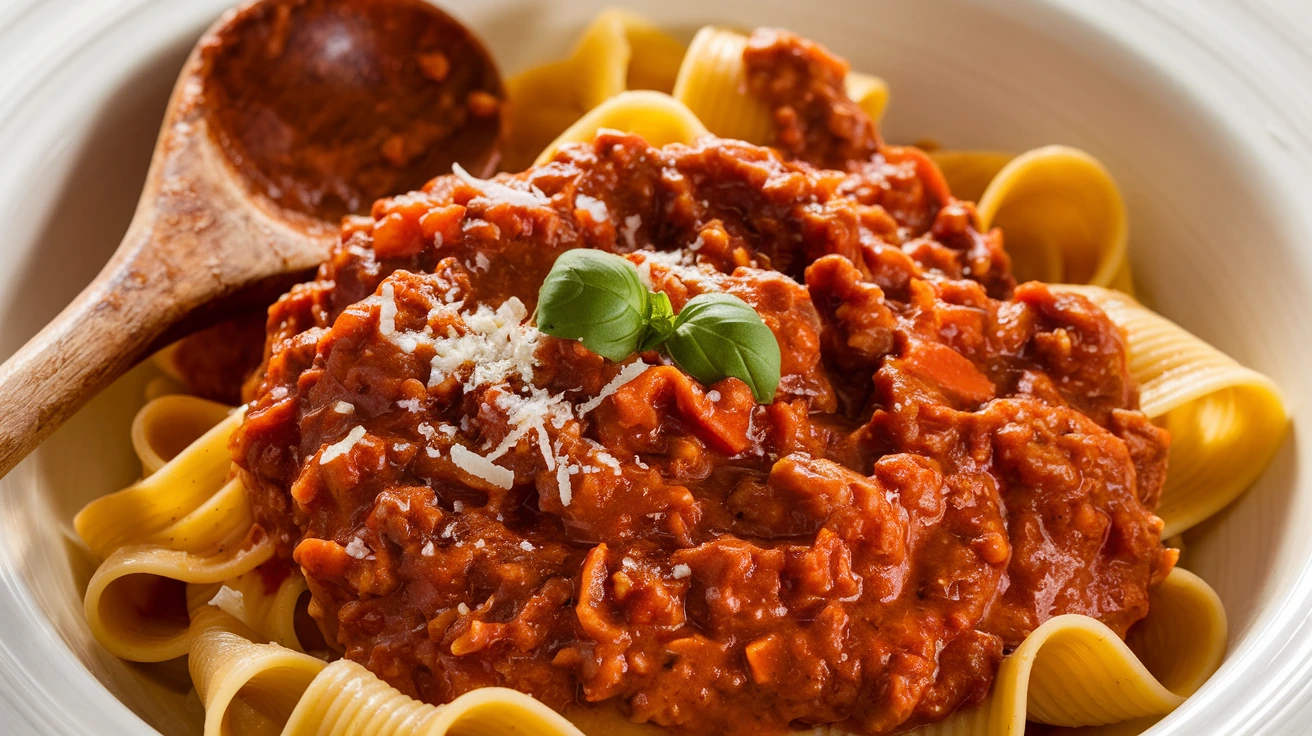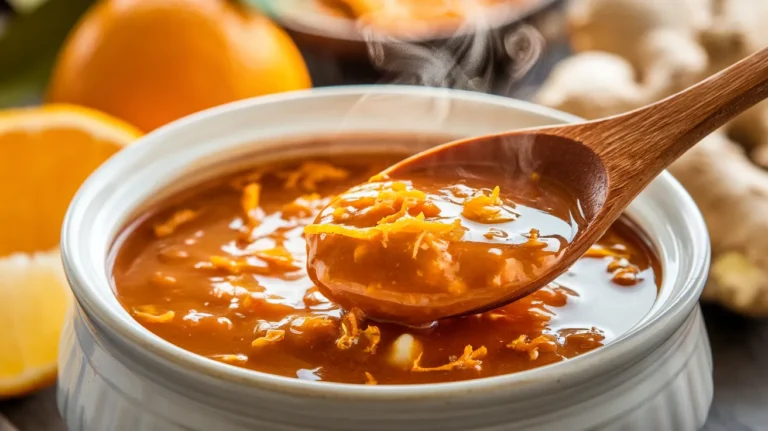- Rich, authentic flavor that develops through slow cooking
- Perfect for meal prep – tastes even better the next day
- Versatile base for lasagna, pasta, and more
- Freezer-friendly for quick weeknight meals
The Secret to Restaurant-Quality Bolognese Sauce at Home
Have you ever tried making Bolognese sauce at home only to end up with something that tastes like basic meat sauce? You’re not alone.
The perfect Bolognese Sauce recipe combines meat, vegetables, and aromatics that simmer slowly until they create a rich, complex flavor. Unlike quick tomato sauces, authentic Bolognese develops its signature taste through patience.
This recipe shows you exactly how to make Bolognese sauce that rivals your favorite Italian restaurant. With just a few key techniques and the right ingredients, you’ll create a sauce that clings perfectly to pasta and delivers incredible depth of flavor.
Nutrition Information
| Nutrient | Amount per Serving |
|---|---|
| Calories | 385 |
| Protein | 24g |
| Carbohydrates | 12g |
| Fat | 28g |
| Fiber | 3g |
| Sodium | 650mg |
| Serving Size | ¼ of recipe (about 1 cup) |
What You’ll Need for Perfect Bolognese Sauce
Ingredients
| Ingredient | Amount | Notes |
|---|---|---|
| Ground beef | 1 pound | 80/20 lean-to-fat ratio |
| Ground pork | ½ pound | For richness |
| Pancetta or bacon | 4 ounces | Diced small |
| Yellow onion | 1 medium | Finely diced |
| Carrots | 2 medium | Finely diced |
| Celery | 2 stalks | Finely diced |
| Garlic | 4 cloves | Minced |
| Tomato paste | 2 tablespoons | |
| Dry red wine | 1 cup | Like Chianti or Sangiovese |
| Whole milk | ½ cup | |
| Crushed tomatoes | 28 ounces (1 can) | |
| Bay leaves | 2 | |
| Fresh thyme | 2 sprigs | |
| Beef broth | 1 cup | Low sodium |
| Olive oil | 2 tablespoons | |
| Salt | 1 teaspoon | Plus more to taste |
| Black pepper | ½ teaspoon | Freshly ground |
| Nutmeg | ⅛ teaspoon | Freshly grated if possible |
| Parmesan rind | 1 (optional) | For extra flavor |
Kitchen Equipment
| Tool | Purpose |
|---|---|
| Dutch oven or heavy pot | For even heat distribution |
| Wooden spoon | For stirring and breaking up meat |
| Sharp knife | For dicing vegetables |
| Cutting board | For prep work |
| Measuring cups and spoons | For accurate measurements |
| Grater | For Parmesan cheese |
Possible Substitutions
- Ground meat: Use all beef if pork isn’t available
- Wine: Replace with additional beef broth if needed
- Pancetta: Bacon works perfectly as an alternative
- Whole milk: Half-and-half or cream can be substituted
- Fresh herbs: Use 1 teaspoon dried thyme if fresh isn’t available
Step-by-Step Instructions
Prep Time: 20 minutes Cook Time: 2 hours 30 minutes Total Time: 2 hours 50 minutes Servings: 4 persons
Preparation Phase
- Prep your vegetables
- Finely dice the onion, carrots, and celery (this mixture is called “soffritto”)
- Mince the garlic cloves
- Dice the pancetta or bacon into small pieces
- Prepare your workspace
- Measure all remaining ingredients and have them ready
- Place your Dutch oven on the stove
- Have a wooden spoon nearby for stirring
Cooking Phase
- Start with the meat base
- Heat olive oil in your Dutch oven over medium heat
- Add the pancetta or bacon and cook until fat renders, about 5 minutes
- Add ground beef and pork
- Break up meat with wooden spoon into small pieces
- Cook until no pink remains, about 8-10 minutes
- Use a slotted spoon to transfer meat to a plate, leaving fat in the pot
- Create the flavor foundation
- In the same pot, add onion, carrots, and celery
- Cook vegetables until softened, about 6-8 minutes
- Add garlic and cook until fragrant, about 30 seconds
- Stir in tomato paste and cook for 2 minutes until darkened slightly
- Deglaze and build the sauce
- Pour in the red wine, scraping the bottom of the pot to release browned bits
- Let wine simmer until reduced by half, about 5 minutes
- Return meat to the pot
- Add crushed tomatoes, beef broth, bay leaves, thyme, salt, pepper, and nutmeg
- Add Parmesan rind if using
- Stir to combine all ingredients
- The low and slow method
- Bring sauce to a gentle boil, then reduce heat to maintain a very slow simmer
- Cover partially with a lid, allowing some steam to escape
- Let sauce simmer for 1.5 hours, stirring occasionally
- Important: Keep heat low enough that sauce doesn’t burn on bottom
- Final enrichment
- Pour in the milk and stir to incorporate
- Continue simmering uncovered for another 30 minutes
- The sauce should thicken and reduce slightly
- Taste and adjust seasoning with salt and pepper as needed
- Remove bay leaves, thyme stems, and Parmesan rind before serving
Serving Suggestions
- Pasta pairing
- Cook 1 pound of pasta (tagliatelle or pappardelle are traditional)
- Reserve ½ cup pasta cooking water before draining
- Toss pasta with sauce and a splash of pasta water to help sauce cling
- Finishing touches
- Top with freshly grated Parmesan cheese
- Garnish with chopped fresh parsley if desired
- Serve with crusty bread for soaking up extra sauce

Troubleshooting Your Bolognese Sauce
| Problem | Solution |
|---|---|
| Sauce is too thin | Continue simmering uncovered to reduce liquid, or add 1-2 extra tablespoons of tomato paste |
| Sauce is too thick | Add a splash of beef broth or pasta water to thin |
| Sauce tastes acidic | Add a pinch of sugar to balance acidity |
| Meat is in large chunks | Break meat up more finely while browning |
| Sauce lacks depth | Add a Parmesan rind during simmering for umami flavor |
Variations and Creative Twists
Classic Variations
- Bolognese with Mushrooms
- Add 8 ounces of finely chopped mushrooms with the vegetables
- This adds earthiness and extra umami flavor
- Works great with cremini or portobello mushrooms
- Spicy Bolognese
- Add ½ teaspoon red pepper flakes when cooking the garlic
- For extra heat, serve with additional red pepper flakes on the side
- Pairs well with a cooling side salad
- White Bolognese
- Skip the crushed tomatoes and tomato paste
- Increase milk to 1.5 cups
- Use white wine instead of red
- Result is a lighter, creamier sauce that’s amazing with chicken or veal
If you love this Bolognese sauce recipe, you might want to try making your own specialty and dipping sauces to complement other dishes in your cooking repertoire.
Storage and Reheating Guidelines
Storage
- Refrigerator: Store cooled Bolognese sauce in airtight containers for up to 4 days
- Freezer: Freeze in portion-sized containers for up to 3 months
- Tip: Label containers with date and contents for easy identification
Reheating
- Stovetop method (best option)
- Place sauce in a saucepan over medium-low heat
- Add 1-2 tablespoons of water or broth to prevent sticking
- Stir occasionally until heated through, about 5-7 minutes
- Microwave method (quickest option)
- Place portion in microwave-safe container
- Cover loosely to prevent splatters
- Heat on 70% power for 2 minutes, then stir
- Continue heating in 30-second intervals until hot
The rich flavors in this sauce actually develop further when stored overnight, making it perfect for enjoying with our copycat Cane’s sauce recipe as a creative dipping option for garlic bread on the side.
Safety Notes and Expert Tips
Food Safety
- Always cook ground meat to an internal temperature of 160°F
- Refrigerate leftovers within 2 hours of cooking
- Never refreeze previously frozen and thawed sauce
- When reheating, ensure sauce reaches 165°F throughout
Pro Tips for Perfect Bolognese
- Dice vegetables very finely (about ¼-inch pieces) for the best texture
- Brown the meat in batches if needed to prevent steaming
- Don’t rush the cooking process – the long simmer is what creates depth of flavor
- Let the sauce rest for 15 minutes before serving to allow flavors to settle
- Cook pasta just shy of al dente when combining with sauce, as it will continue cooking
Looking to branch out with your sauce-making skills? Learn how to make Bitchin’ sauce for a completely different flavor profile that’s just as versatile.
Recipe FAQ
Q: Can I make Bolognese sauce in a slow cooker? A: Yes! Brown the meat and vegetables as directed, then transfer to a slow cooker. Cook on low for 6-8 hours.
Q: Why add milk to Bolognese sauce? A: Milk adds richness and helps tenderize the meat, creating that signature silky texture.
Q: Is this recipe gluten-free? A: The sauce itself is gluten-free. Just serve with gluten-free pasta.
Q: Can I double this recipe? A: Absolutely! Double all ingredients and use a larger pot. Cooking time remains the same.
Q: What’s the difference between Bolognese sauce and regular meat sauce? A: Bolognese is richer, contains milk, has less tomato, and cooks for much longer to develop complex flavors.




